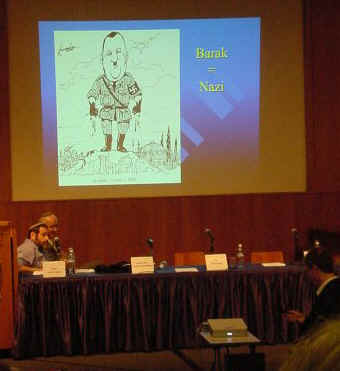

Opening Ceremonies and Day One
|
|
Opening Ceremonies
The opening ceremonies of the conference took place on August 8 after our tour of the campus. The first speaker addressing representatives from thirty-one nations was Israel's Minister of Trade and Labor and deputy Prime Minister, Mr. Ehud Olmert. He asked, "how to do keep the Holocaust relevant for future generations?" With the loss of the survivors to old age and a new wave of worldwide ant-Semitism, lessons on the Holocaust have new urgency. The Chairman of the Yad Vashem directorate, Mr. Avner Shalev, pointed out that many students today equate Israel's actions against the Palestinians with those of the Nazis, and Holocaust deniers are on the rise. These trends make the conference an important opportunity to exchange methodologies and generate dialogue on where our priorities lie as educators. Learning through travel is another method for cultural exchange. As for me, teachers can also use the Internet to help their students understand the events and causes of the Holocaust, but they can also share their findings as a result of the conference using that same global communications tool. |
||
| First Plenary
Session: August 9, 2004 Theme: The role of the Shoah in Jewish Education - The Challenge of the 21st Century. Rabbi Prof. Yitzhak Greenberg, President of Jewish
Life Network/ Steinhardt Foundation Spiritual forces: The Shoah gave renewed meaning to the coming of the Messianic Age that is so central to Jewish thought. God's creation encountered forces of destruction even as God's own creation generated the devastation that was the Holocaust. This contradiction may never find reconciliation within Jewish education, but it is a spiritual force that brings the Holocaust to the forefront of Jewish curricular development. Theological forces: Monotheistic religion is one of the contributions of Jewish thought to Western civilization. The Holocaust brought into question the existence of a benevolent, omniscient being. The evil and horror that found expression though Nazi terror is almost impossible to explain if the existence of an all-powerful creator is accepted as truth. Theologians found themselves at pains to explain it, and many explanations fall into anti-Semitic rhetoric. Were the Jews being punished for some failure? Many Jews, especially survivors, still grapple with the question "Where was God?" or "Was God in Auschwitz?" As the Jewish population had to heal from its wound caused by the Shoah, so their souls had to integrate and ameliorate the history of the Shoah into their theological views. This process continues even 60 years after the event.
Reshaping Jewish Identity The Holocaust could only have occurred in modern history. Destruction,
murder, war, technology, bureaucratization, hatred: all fueled the modern
machinery of genocide within the Nazi state. In the modern world, students
of the Holocaust must have an understanding of what it means to be a Jew
before they attempt to master the history of the Holocaust. This premise
is critical more Jewish students who seek to understand their own
culture's world view. Jewish self-critique must include an examination of
anti-Christian stereotypes. As Jewish education seeks to understand the
causes and course of the Holocaust, it must also seek to build
reconciliation between its own identity and the rest of the world. This
process will hasten the creation of the Jewish ideal of the perfection of
the world. |
|||
 |
Dr. Jöel Kotek, Centre
Documentation Juive Contemporaine, Paris Dr. Kotek told us that he gives his students a "diagnostic Holocaust test," which will assess students' prior knowledge of the Holocaust. I read about a similar technique in Samuel Totten's Holocaust Education, Issues and Approaches (2002). He asserted Jewish students come to the classroom with a sort of "ignored ignorance" of the Shoah and its impact on their own lives. Students lack positive and rational responses to questions on the Holocaust that cry for correction and informative responses. Dr. Kopek was critical of the global media for using the Holocaust to accuse Israel of misuse of power, specifically against the Palestinians. He asserts: The Shoah is unique -- it cannot be applied to other abuses of power. (My note: but can it be used to guide behavior so as to prevent abuses of power?) Studying the Holocaust calls for being a better global citizen. Understanding the place of the Holocaust in history must motivate an awareness of other genocides, especially the recent 1994 Rwandan genocide and the ongoing conflict in Darfur, Sudan). |
||
Presentation: Hadasa and Clilc Bau: Rebecca and Joseph Bau: The Miracle of Schilder's Survivors
The Bau sisters are second generation survivors, but they avoided many of the emotional problems faced by those who must deal with their parents' trauma. The fact that their parents openly discussed their experiences helped bring the issues into the light. Bau's art continues to educate and inspire teachers and students of the Holocaust as the Bau sisters travel the world to tell the story of their parents. They also hope to maintain a Bau art gallery in Tel Aviv. Above: a Bau Holocaust cartoon |
|||
| Day One | Day Two | Day Three |
| To Photo Album | ||
All Images
© George Cassutto, 2004
(Except otherwise noted)